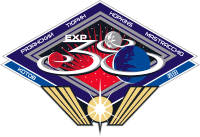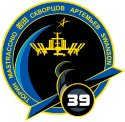Expedition 38
| Expedition 38 | |||
 | |||
| Uppdragsstatistik | |||
|---|---|---|---|
| Rymdstation: | ISS | ||
| Start: | 10 november 2013[1] | ||
| Slut: | 10 mars 2014[1] | ||
| Antal besättningsmedlemmar: | 6 st | ||
| Rymdpromenad | |||
| Antal rymdpromenader: | 4 st | ||
| Total tid: | 27 timmar, 13 minuter | ||
| Transport | |||
| Uppskjutning: | med Sojuz TMA-09M, Sojuz TMA-10M | ||
| Uppskjutningsplats: | Kosmodromen i Bajkonur | ||
| Landning: | med Sojuz TMA-09M, Sojuz TMA-10M | ||
| Landningsplats: | Kazakstan | ||
| Kronologi | |||
| |||

Expedition 38 var den 38:e expeditionen till Internationella rymdstationen (ISS). Expeditionen började den 10 november 2013 då delar av Expedition 37s besättning återvände till jorden med Sojuz TMA-09M.
Koichi Wakata, Richard A. Mastracchio och Michail Tiurin anlände till stationen med Sojuz TMA-11M den 7 november 2013
Expeditionen avslutades den 10 mars 2014 då Oleg Kotov, Sergej Rjazanskij och Michael S. Hopkins återvände till jorden med Sojuz TMA-10M.
Besättning
| Position | Första delen (10 september - 7 november 2013) | Andra delen (7 november- 10 mars 2014) |
|---|---|---|
| Befälhavare | Hans tredje rymdfärd | |
| Flygingenjör 1 | Hans första rymdfärd | |
| Flygingenjör 2 | Hans första rymdfärd | |
| Flygingenjör 3 | Hans fjärde rymdfärd | |
| Flygingenjör 4 | Hans fjärde rymdfärd | |
| Flygingenjör 5 | Hans tredje rymdfärd | |
Referenser
- ^ [a b] NASA's Space Station Expedition 38 Arkiverad 16 augusti 2019 hämtat från the Wayback Machine., läst 3 september 2016.
Externa länkar
| |||||||||||||||||||
Media som används på denna webbplats
ISS Expedition 38 Patch
As the International Space Station (ISS) has become a stepping stone to future space exploration, the Expedition 38 mission patch design paints a visual roadmap of exploration beyond low Earth orbit, most prominently represented by the design's flowing Expedition 38 mission numbers that wrap around Earth, the moon and Mars. Just as the sun is a guiding light in the galaxy, the ISS illuminates the bottom of the design as it is a shining beacon of the advancement of science, knowledge, and technology carried out aboard the Space Station. To visually capture the idea of the ISS being a foundation for infinite discovery, the space station's iconic solar arrays span upwards, providing the number 38 and its exploration roadmap a symbolic pedestal to rest on. Finally, the overall use of red, white, and blue in the design acknowledges the flags of the countries of origin for Expedition 38's crew -- the United States, Russia, and Japan.
ISS Expedition 39 Patch
Increment 39 of the International Space Station Program marks the 15th year of operation since the start of the space laboratory assembly. Today, the U.S., Russia, Japan, Canada and the European Space Agency are partnering in the operation of the largest ever orbital outpost managed by humankind. The names of the six crew members are depicted in their native languages. For Expedition 39, the Soyuz spacecraft serves as transport vehicle for the crew members to and from the station. During this expedition, the ISS will serve as a platform for scientific research, Earth and astronomical observation, education, as well as a stage for the development of new technologies used for the exploration beyond low Earth orbit. The star above the complex signifies human space exploration towards new frontiers. The crew members added these words: "The crew of Expedition 39 is proud to serve the international community in furthering our scientific knowledge and in expanding human presence in space."
Expedition 38 crew members take a break from training at NASA's Johnson Space Center to pose for a crew portrait. Pictured on the front row are Koichi Wakata (left), flight engineer; and Russian cosmonaut Oleg Kotov, commander. Pictured from the left (back row) are Russian cosmonaut Mikhail Tyurin, NASA astronaut Rick Mastracchio, Russian cosmonaut Sergey Ryazanskiy and NASA astronaut Michael Hopkins, all flight engineers.
Leonardo da Vinci's Vitruvian Man, created some 525 years ago, as a blend of art and science and a symbol of the medical profession, is depicted amongst the orbits of a variety of satellites circling the Earth at great speed. Da Vinci's drawing, based on the proportions of man as described by the Roman architect Vitruvius, is often used as a symbol of symmetry of the human body and the universe as a whole. Almost perfect in symmetry as well, the International Space Station, with its solar wings spread out and illuminated by the first rays of dawn, is pictured as a mighty beacon arcing upwards across our night skies, the ultimate symbol of science and technology of our age. Six stars represent the six members of Expedition 37 crew, which includes two cosmonauts with a medical background, as well as a native of Da Vinci's Italy.






